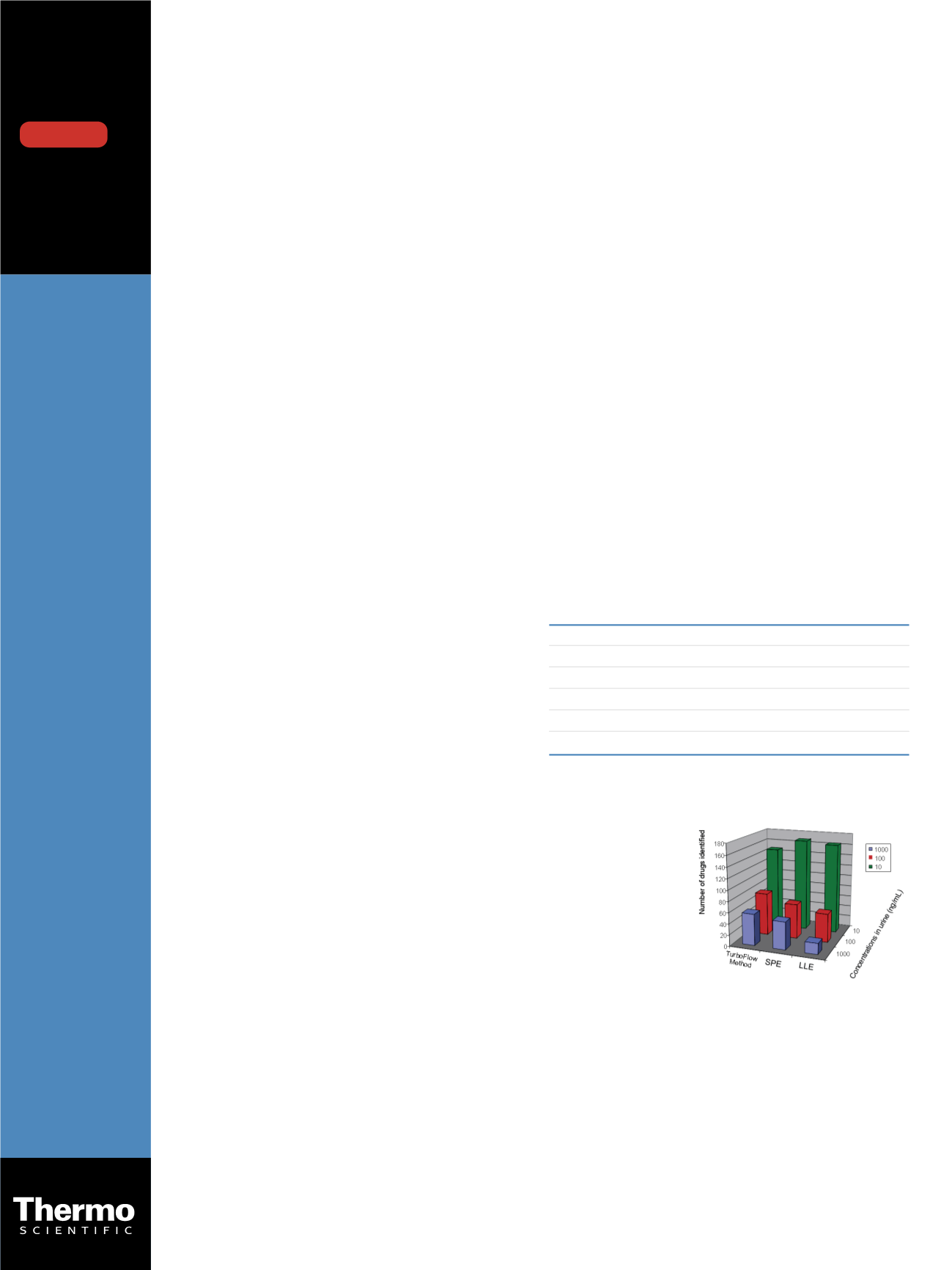

Forensic Toxicology Screening with LC-MS/MS
and Automated Online Sample Preparation
Guifeng Jiang, Marta Kozak, Subodh Nimkar, Thermo Fisher Scientific, San Jose, CA, USA
Forensic Toxicology Use Only.
Application
Note: 507b
Key Words
• ToxSpec Analyzer
• ToxID Software
• LXQ Linear Ion
Trap
• TurboFlow
Technology
• Forensic
Toxicology
Introduction
The quality of liquid chromatography-mass spectrometry
(LC-MS) data collected in forensic drug screening applica-
tions is largely affected by sample preparation methods.
Offline solid phase extraction (SPE) and liquid-liquid extrac-
tion (LLE) are the most commonly used methods. Auto-
mated online sample preparation using Thermo Scientific
TurboFlow technology provides a robust front end platform
for forensic drug screening, which is convenient and labor-
saving.
Goal
The goal is to evaluate the performance of three sample
preparation techniques – TurboFlow™ technology, SPE, and
LLE – to screen 300 basic, neutral, and acidic drug com-
pounds for forensic toxicology use.
Experimental
SPE –
Mixed-mode Thermo Scientific HyperSep Verify-CX
SPE cartridges (200 mg; 6 mL) were used for offline SPE.
Samples of 1 mL of urine were spiked to final concentra-
tions of 10, 100 and 1000 ng/mL with analytes of interest,
as well as 100 ng/mL of three deuterated internal standards,
and loaded on the SPE column. Basic, acidic, and neutral
fractions were collected, combined, evaporated to dryness,
reconstituted in 100 µL, and injected onto the LC column.
LLE –
Toxi-Tubes
®
A & B (Varian) were used for offline LLE.
Samples of 1 mL of urine were spiked to final concentra-
tions of 10, 100 and 1000 ng/mL with analytes of interest,
as well as 100 ng/mL of three deuterated internal standards,
and then applied to the Toxi-Tube. The organic layers were
transferred, evaporated to dryness, reconstituted in 100 µL,
and injected onto the LC-MS.
TurboFlow Method –
Urine samples were diluted in ratio
1:1 v/v with 50% MeOH containing internal standards.
Fifty (50) µL of diluted sample was injected onto the Turbo-
Flow columns. Two different chemistry TurboFlow columns
were used to extract chemically diverse compounds.
A 12-minute LC method was developed for TurboFlow
and LLE samples. Samples were injected onto a Thermo
Scientific Hypersil GOLD PFP 100 x 30 mm, 3 µm column.
A gradient method was employed with flow rates
of 600 µL/min. For offline SPE samples, a 13-minute LC
gradient was used with a Thermo Scientific Hypersil GOLD
PFP analytical column (50 x 2.1 mm, 5 µm) and a
200 µL/min flow rate.
Mass Spectrometry
All samples were analyzed on the Thermo Scientific ToxSpec
Analyzer system equipped with a Thermo Scientific LXQ
linear ion trap mass spectrometer and an electrospray ion-
ization (ESI) source using a scan-dependent, polarity-switch-
ing method. Reports were automatically produced with
Thermo Scientific ToxID automated forensic toxicology
screening software, including lists of identified compounds
and their matching MS/MS spectrum.
Results and Discussion
Table 1 shows limits of identification for representative
compounds from the SPE, LLE, and TurboFlow methods.
The lowest concentration validated was 10 ng/mL. All three
methods showed comparable limits of identification. In ad-
dition, with the automated TurboFlow method, the sample
quantity loaded on the column was one-quarter of that in
the SPE method and one-eighth of that in the LLE method.
Table 1. Comparison of limits of identification for selected compounds
TurboFlow Method
SPE Method
LLE Method
Compound
(ng/mL in urine)
(ng/mL in urine)
(ng/mL in urine)
Codeine
10
10
10
Hydrocodone
10
10
10
Cocaine
10
10
10
Amphetamine
10
10
1000
Stanozolol
100
100
10
Diazepam
10
10
10
Figure 1 shows the results of the identification limits
of 300 drugs with the three sample preparation meth-
ods. Compared to
traditional sample
preparation meth-
ods, the automated
TurboFlow method
provides competent
performance with
automated online
sample preparation.
Figure 1: Limits of identification of 300 compounds
Conclusion
The TurboFlow method with the ToxSpec™ Analyzer al-
lows for the identification of 300 drugs, with limits of detec-
tion (LODs) ranging from less than 10 ng to greater than
1000 ng per milliliter of urine. It provides an automated
online sample preparation platform for forensic toxicol-
ogy screening with competent performance and limits of
identifications. The TurboFlow method is easier, faster, and
cost efficient in comparison to traditionally used SPE and
LLE methods.
DOWNLOAD


















